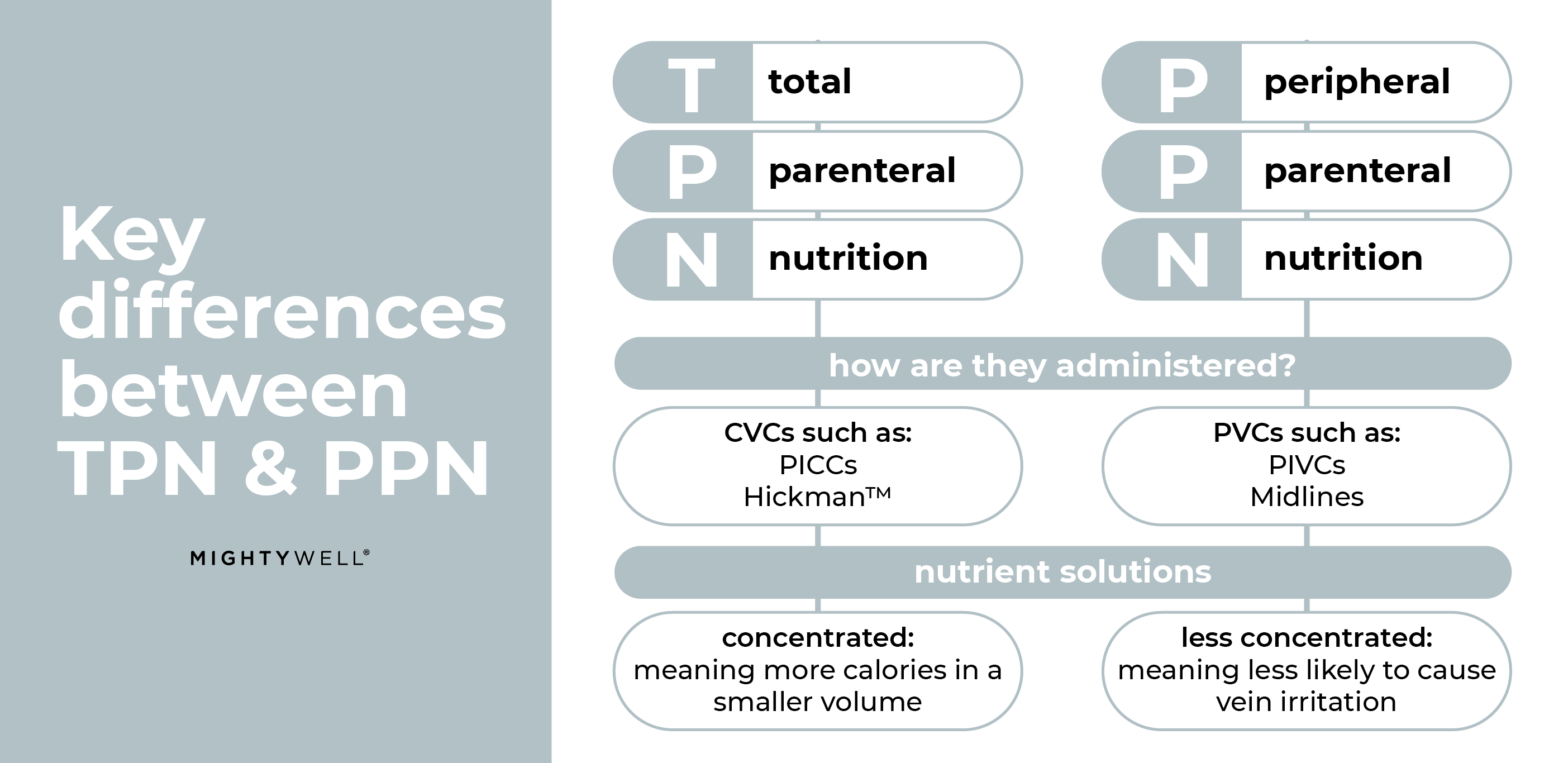Parenteral nutrition is a form of nutrition support that delivers nutrients directly into the bloodstream. This type of nutrition supports patients who cannot obtain adequate nutrition through the digestive tract. Parenteral nutrition can provide all of the nutrients a person needs or can be used to supplement the nutrients that a person can obtain from other sources, such as solid or blended food.
Two critical factors to consider about parenteral nutrition include understanding what nutrients it provides and how parenteral nutrition is delivered, which we will review below:
There are two main types of parenteral nutrition (PN):
- total parenteral nutrition (TPN)
- peripheral parenteral nutrition (PPN)
Both TPN and PPN provide vital nutrients, but there are some crucial differences between the two. In this blog post, we’ll explore the key differences between TPN vs. PPN so that you can make the best decision for your health.
1. Administration of TPN vs. PPN
The first difference between TPN vs. PPN is in how they are administered.
- TPN is given through a central venous catheter (CVC), which is placed in a large vein near your heart. Common types of CVCs include Tunneled Central Venous Catheters, including Hickman™ , Broviac™, Leonard™ lines, and Peripherally Inserted Central Catheters (PICCs). You can learn more about CVCs here.
- PPN is given through a peripheral venous catheter (PVC), which is placed in a smaller vein in your arm, either through a Peripheral Intravenous catheter (PIVC) or a Midline.
2. Nutrient solutions received on TPN vs. PPN
The second difference between these two types of parenteral nutrition is in the nutrient solutions that are used:
- TPN solutions are typically more concentrated than PPN solutions, meaning that they can provide more calories and protein in a smaller volume. Additionally, because TPN solutions are more concentrated, they can irritate veins and cause inflammation. For these reasons, TPN solutions must be given through a CVC.
- PPN solutions, on the other hand, are less concentrated and can be given through either a PVC or an infusion port. While PPN solutions may not provide as many calories and protein as TPN solutions, they are less likely to cause vein irritation or inflammation. Additionally, because PPN solutions can be given through a chest port, they may be a more convenient option for some patients.
Some of the candidates for TPN include the following:
- Patients with paralyzed or nonfunctional GI tract or conditions that require bowel rest, such as small bowel obstruction, ulcerative colitis, or pancreatitis
- Patients who have had nothing by mouth (NPO) for seven days or longer
- Critically ill patients
- Babies with an immature gastrointestinal system or congenital malformations
- Patients with chronic or extreme malnutrition, or chronic diarrhea or vomiting with a need for surgery or chemotherapy
- Patients in hyperbolic states, such as burns, sepsis, or trauma
Organizing TPN & PPN solutions and supplies
The TPN solution comes in a 2-3 liter bag, and most patients infuse one bag daily. The bag is often connected to an Electronic Infusion Device (EID) system, also known as an infusion pump, to “deliver the fluids at the correct rate and volume.” These infusion pumps also “include a variety of safety features including alerts for air and occlusions, a medication administration library, the ability to calculate infused volumes and back up battery power” (Anderson, Renée, et al. 2018).
The whole set fits nicely into the Fluid Motion Backpack, which can be worn by the patient or hung nearby throughout the infusion. This backpack can act as a replacement for an IV pole for increased convenience and ease of use for patients who are on an infusion schedule. The Fluid Motion Backpack is designed to help patients be as mobile as they would like to fit their lifestyle – while accommodating medical and personal essentials.
As covered, TPN and PPN are both types of parenteral nutrition that provide vital nutrients to patients. The main difference between these two types of parenteral nutrition is their administration and the nutrient solutions used. There is another type of alternative nutrition called “enteral nutrition.” You can check out this post to learn more about the difference between parenteral and enteral nutrition. As always, speak with your healthcare team to determine which type of parenteral nutrition is right for you.
Sources:
Anderson, Renée, et al. “8.6 Infusing IV Fluids by Gravity or an Electronic Infusion Device.” Clinical Procedures for Safer Patient Care, Thompson Rivers University, 31 Aug. 2018, https://pressbooks.bccampus.ca/clinicalproceduresforsaferpatientcaretrubscn/chapter/8-6-infusing-iv-fluids-by-gravity-or-an-electronic-infusion-device-pump/.
Doyle, Glynda Rees, and Jodie Anita McCutcheon. “8.8 Total Parenteral Nutrition (TPN).” Clinical Procedures for Safer Patient Care, BCcampus, 23 Nov. 2015, https://opentextbc.ca/clinicalskills/chapter/8-8/.

